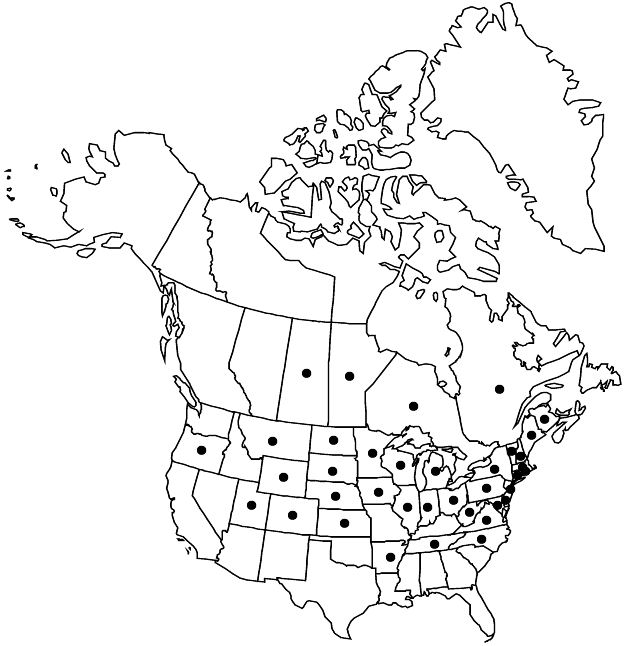Prunus pumila
Mant. Pl. 1: 75. 1767.
Shrubs, sometimes suckering, 1–15 (–25) dm, not thorny. Twigs with terminal end buds, glabrous or sparsely to densely puberulent (var. susquehanae). Leaves deciduous; petiole 2–10 (–13) mm, glabrous or hairy only when young, sometimes glandular distally or on margins at bases of blades, glands 1–2; blade elliptic, oblanceolate, or obovate, 2.5–8 × 0.8–3 cm, base obtuse, cuneate, or long-attenuate, margins crenulate-serrulate to serrate in distal 1/2–2/3, teeth sharp or blunt, callus-tipped, sometimes glandular, apex short-acuminate to rounded, surfaces glabrous. Inflorescences 2–5-flowered, umbellate fascicles. Pedicels 3–19 mm, glabrous. Flowers blooming before leaf emergence; hypanthium campanulate, 1.7–3 mm, glabrous externally; sepals erect to reflexed, semicircular, 1.3–2.8 mm, margins glandular-toothed, surfaces glabrous; petals white, oblanceolate, oblong, or suborbiculate, 3–9 mm; ovaries glabrous. Drupes dark purple to nearly black, subglobose or broadly ellipsoid, 6–12 mm, glabrous; mesocarps fleshy; stones subglobose, ovoid, or fusiform, not flattened.
Distribution

Man., N.B., Ont., Que., Sask., Ark., Colo., Conn., Del., Ill., Ind., Iowa, Kans., Maine, Mass., Md., Mich., Minn., Mont., N.C., N.Dak., N.H., N.J., N.Y., Nebr., Ohio, Oreg., Pa., R.I., S.Dak., Tenn., Utah, Va., Vt., W.Va., Wis., Wyo.
Discussion
Varieties 4 (4 in the flora).
Opinion has varied as to whether Prunus pumila is best treated as one variable species (for example, H. Groh and H. A. Senn 1940; H. A. Gleason 1952; J. R. Rohrer 2000) or as two, three, or four separate species (for example, W. F. Wight 1915; M. L. Fernald 1923b; P. M. Catling et al. 1999). The plants vary in stem posture, twig indument, leaf shape, fruit size and taste, pit size and shape, and ecologic preference. Even though the morphologic characters show almost continuous variation, four varieties are recognized here based largely on differences in ecologic habitat and geographic range.
Selected References
None.
Lower Taxa
Key
| 1 | Twigs densely puberulent (10× magnification); leaf apices usually obtuse, sometimes acute or rounded, blade lengths ca. 2.6 times widths; sandy pine-oak woods or barrens with open canopy, or adjacent fields and lakeshores. | Prunus pumila var. susquehanae |
| 1 | Twigs usually glabrous, sometimes sparsely puberulent; leaf apices short-acuminate, acute, or obtuse, blade lengths ca. 2.9–3.7 times widths; usually in open habitats | > 2 |
| 2 | Stems prostrate to decumbent; leaf blades oblanceolate, lengths ca. 3.7 times widths; stones ovoid to fusiform, 4.5–5 mm wide. | Prunus pumila var. depressa |
| 2 | Stems usually erect-ascending, sometimes decumbent or sprawling; leaf blades elliptic, obovate, or oblanceolate, lengths ca. 2.9–3.3 times widths; stones subglobose to ovoid, 5–7 mm wide | > 3 |
| 3 | Leaf blades usually oblanceolate, lengths ca. 3.3 times widths; shores of the Great Lakes on sandy, gravelly, or rocky beaches, dunes, and interdunal flats. | Prunus pumila var. pumila |
| 3 | Leaf blades elliptic, oblanceolate, or obovate, lengths ca. 2.9 times widths; sandy prairies, oak savannas, rock outcrops. | Prunus pumila var. besseyi |
"dm" is not declared as a valid unit of measurement for this property.